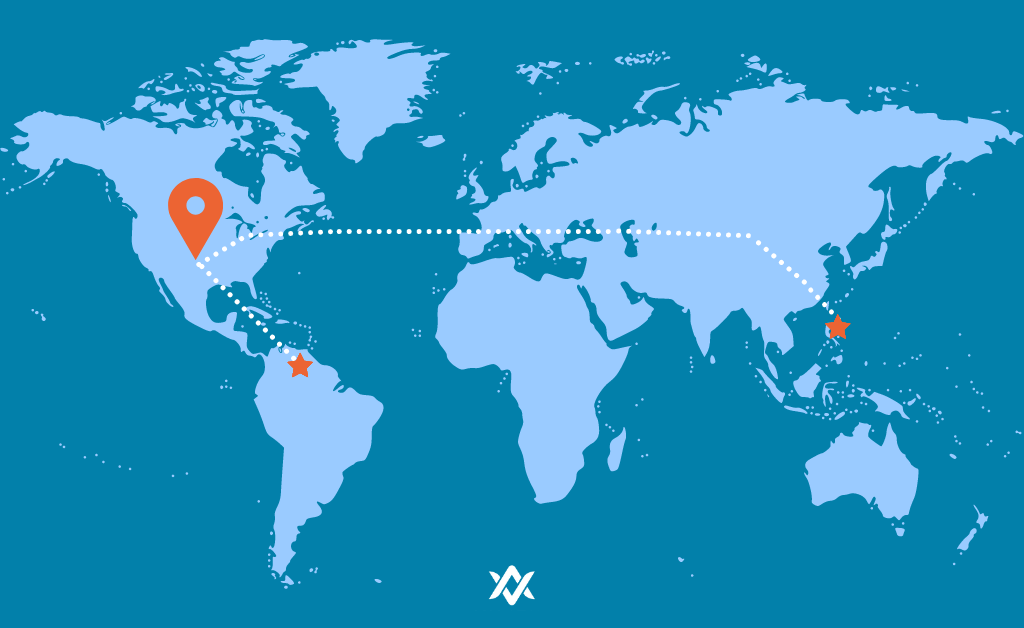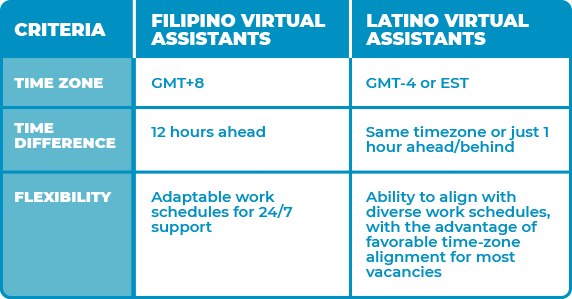For over two decades, the Philippines has dominated outsourcing, securing 15% of the global market share despite comprising only 1.4% of the world’s population.
However, more recently, the concept of near-shoring has grown in popularity, and increasingly entrepreneurs are looking closer to home by considering hiring Virtual Assistants from places like Venezuela, Colombia, and Argentina.
Drawing on extensive experience in both offshoring and near-shoring, we asked our CEO, Dan Baker to offer insights into 5 key considerations for business owners navigating this choice.
Having hired and managed outsourced teams in both the Philippines and Latin America, his experience could be helpful for business owners considering where to source remote teams from.
You might also be wondering, “how can a virtual assistant help my business?“ A skilled virtual assistant can streamline your tasks, manage schedules efficiently, and enhance overall productivity, providing valuable support tailored to your company’s needs.

Key points of Filipino and Latin American virtual assistants
In evaluating virtual assistant options, this exploration focuses on key points differentiating the offerings in the Philippines and Latin America. Streamlining the nuances, it aims to provide practical insights for business owners navigating their choices in remote support.
1. Time-zone work variations for Filipino and Latino Virtual Assistants
Navigating the operational dynamics of virtual assistants requires a keen understanding of time-zone work variations, particularly when considering Filipino and Latino professionals. This exploration delves into the temporal aspects of remote support, shedding light on how time-zone differences can impact collaboration and efficiency.
The Philippines is exactly 12 hours ahead of the US East Coast during the summer months, while Latin American countries are mostly on Eastern Time or 1 hour ahead or behind. This gives LATAM a big advantage for most types of vacancies, allowing employers to have teams working in their time zone without having to work unsocial hours.
“Because the BPO industry in the Philippines is so developed and employees are used to working for North American employers, it’s quite common to find freelancers willing to work to your schedule. In our opinion this isn’t ideal. Sleeping all day and missing all their family/social time in order to work every night is not an ideal situation. Also, thinking selfishly, even if we did this it’d lead to much higher staff turnover rates.” – Dan Baker.

2. The cultural affinity between Latin America and the United States
In our experience, the cultural connection between Latin American virtual assistants and Western counterparts is paramount for effective communication and teamwork, resulting in superior outcomes for businesses.
As Wow Remote Teams notes, “Virtual Assistants in Latin America have a better understanding of American culture than their Filipino counterparts. This cultural connection is critical for effective communication and teamwork, resulting in better outcomes for businesses.”
The author, having lived in Latin America for a decade, acknowledges a slight bias but contends that Latinos, in general, share more cultural similarities with Americans, Canadians, and Brits than individuals from Asia. This affability translates to a collaborative and proactive work environment, making Latin American virtual assistants stand out in problem-solving and initiative.
Considering nearshoring vs. offshoring? While both offer cost savings, nearshoring, with its geographical proximity, often ensures better communication, cultural alignment, and collaboration, making it an advantageous choice for businesses seeking a strategic edge.
3. Filipino and Latino Virtual Assistants are bilingual
Filipino and Latino Virtual Assistants are bilingual, though finding perfect English with a neutral accent is uncommon. However, with strategic recruitment, individuals with a high level of English proficiency can be identified.
With Hispanic and Latin Americans comprising 18% of the US population, there’s an increasing acceptance of Latin-accented English, making Latin American near-shore solutions more widely embraced, especially for customer service and remote customer-facing roles.
4. VAs cost in the Philippines and South America
Both Filipino and Latin American Virtual Assistants offer significant cost savings compared to hiring in-person or locally for remote roles. In our experience, the two regions are similarly priced, with Asia probably being slightly cheaper than Latin America. But often, the quality of workers is better in Latin America, which, along with other advantages compensates for slightly higher costs.
As Medium.com notes, “One primary factor that makes the Philippines a favored choice for outsourcing VAs is its cost-effectiveness. On average, you can expect to pay between $5 to $12 per hour for a new VA and $12 to $30 for a highly skilled VA in the Philippines.”
5. BPO Staff Challenges in Asia vs. Latin America
In the Philippines and Asia, oversaturation in the BPO market results in skilled workers frequently switching jobs, driven by the allure of better opportunities. The prevalence of freelancing exacerbates this trend, making staff retention challenging.
In Latin America, the less developed state of the BPO industry contributes to a more stable workforce. While challenges may exist in finding specialists, the reduced competition results in lower staff turnover, allowing employers to build enduring partnerships with employees. The choice between these regions balances access to a skilled workforce with the goal of maintaining a stable and committed team.
How to choose between South American and Philippines virtual assistants
In comparing South American and Filipino virtual assistants, various factors come into play. The Philippines boasts a highly developed BPO industry and cost-effectiveness; however, market oversaturation leads to higher staff turnover.
In contrast, South America’s less mature BPO industry offers a stable workforce, facilitating the development of long-term working relationships.
Ultimately, your decision should align with your priorities. If you value a highly developed industry, cost-effectiveness, and English proficiency, the Philippines may be a suitable choice. On the other hand, if you prioritize a stable workforce, cultural alignment, and the potential for growth and long-term relationships, South America could be a preferred option.
In the choice between agency vs. freelancer, an agency brings the benefits of a curated pool of professionals, rigorous vetting, and ongoing support, providing a reliable and efficient solution for businesses looking for expertise and flexibility in their virtual teams.
Where to hire a virtual assistant from South America
For personalized assistance in choosing between South American and Filipino virtual assistants, visit our Valatam page to explore how we can meet your specific needs and find your perfect assistant.
Discover how our tailored approach can elevate your remote staffing experience and contribute to the success of your business.

About the author
Dan Baker is the Founder & CEO of Valatam (Virtual Assistance Latin America), a US startup that specializes in providing Virtual Assistants and remote teams to its 120+ clients. Prior to founding Valatam, Dan was the Director of Outsourcing for a British investment consulting firm, where he was tasked with establishing remote teams in Asia and Latin America. For more information regarding Valatam's services visit www.valatam.com

